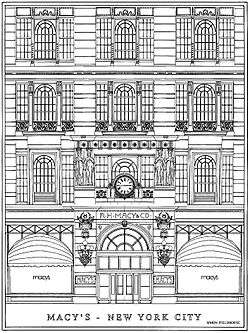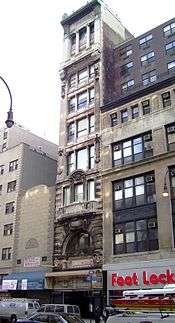Macy's Herald Square
|
R. H. Macy and Company Store | |
|
(1907) | |
| Location | 151 West 34th St., Manhattan, New York City |
|---|---|
| Coordinates | 40°45′1″N 73°59′18″W / 40.75028°N 73.98833°WCoordinates: 40°45′1″N 73°59′18″W / 40.75028°N 73.98833°W |
| Built | 1901 |
| Architect | De Lemos & Cordes |
| NRHP Reference # | 78001873 |
| Significant dates | |
| Added to NRHP | June 2, 1978[1] |
| Designated NHL | June 2, 1978[2] |
Macy's Herald Square, originally known as the R. H. Macy and Company Store, is the flagship of Macy's department stores, located on Herald Square in Manhattan, New York City. The building's 2.2 million square feet (almost 205,000 square meters)[3] has made it the world's largest department store since 1924. As of 2016, the store has stood at the site for 115 years.
The building was added to the National Register of Historic Places as a National Historic Landmark in 1978.[2][1][4]
History

Macy's was founded by Rowland Hussey Macy, who between 1843 and 1855 opened four retail dry goods stores, including the original Macy's store in downtown Haverhill, Massachusetts, established in 1851 to serve the mill industry employees of the area. They all failed, but he learned from his mistakes. He moved to New York City in 1858 and established a new store named "R.H Macy Dry Goods" at Sixth Avenue on the corner of 14th Street. On the company's first day of business on October 28, 1858 sales totaled $11.08, equivalent to $303.00 today. From the very beginning, Macy's logo has included a star in one form or another, echoing a red star-shaped tattoo that Macy got as a teenager when he worked on a Nantucket whaling ship.[5][6]
As the business grew, Macy's expanded into neighboring buildings, opening more department stores, and used publicity devices such as a store Santa Claus, themed exhibits, and illuminated window displays to draw in customers.[7] The store later moved to 18th Street and Broadway, on the "Ladies' Mile", the elite shopping district of the time, where it remained for nearly forty years.
In 1875, Macy took on two partners, Robert M. Valentine (1850–1879), a nephew; and Abiel T. La Forge (1842–1878) of Wisconsin, who was the husband of a cousin.[8][9] Macy died just two years later in 1877 from Bright's disease,[10] The following year La Forge died and Valentine died in 1879.[8][9] Ownership of the company was passed down through the Macy family until 1895, when the company, now called "R. H. Macy & Co.", was acquired by Isidor Straus and his brother Nathan Straus, who had previously held a license to sell china and other goods in the Macy's store.
In 1902, the flagship store moved uptown to Herald Square at 34th Street and Broadway, so far north of the other main dry goods emporia that it had to offer a steam wagonette to transport customers from 14th Street to 34th Street.[11] Although the Herald Square store initially consisted of just one building, it expanded through new construction, eventually occupying almost the entire block bounded by Seventh Avenue on the west, Broadway on the east, 34th Street on the south and 35th Street on the north, with the exception of a small pre-existing building on the corner of 35th Street and Seventh Avenue and another on the corner of 34th Street and Broadway. This latter 5-story building was purchased by Robert H. Smith in 1900 for $375,000 – an incredible sum at the time – with the idea of getting in the way of Macy's becoming the largest store in the world: it is largely supposed that Smith, who was a neighbor of the Macy's store on 14th Street, was acting on behalf of Siegel-Cooper, which had built what they thought was the world's largest store on Sixth Avenue in 1896. Macy's ignored the tactic, and simply built around the building, which now carries Macy's "shopping bag" sign by lease arrangement.[12] That building earned the name Million Dollar Corner when it was finally sold for a then record $1,000,000 on December 6, 1911.[13]
The original Broadway store, designed by architects De Lemos & Cordes and built in 1901–02 by the Fuller Company. It has a Palladian facade, but has been updated in many details. Other additions to the west were added in 1924 and 1928, and the Seventh Avenue building in 1931, all designed by architect Robert D. Kohn, the newer buildings becoming increasingly Art Deco in style.[12][14] The store boasts several wooden escalators still in operation.
In 2012, Macy’s began the first full renovation of the iconic Herald Square flagship store at a reported cost of $400 million.[15][16] Studio V Architecture, a New York-based firm, was the overall master plan architect of the project. The firm's design raised controversy over the nature of contemporary design and authentic restoration.[17]
In August 2014, Macy's agreed to a $650,000 penalty proposed by the New York Attorney General to settle a number of claims of racial profiling and false detention involving nearly two dozen African-American, Latino and other customers at the Herald Square store, who had lodged complaints in February 2013. As part of the deal, the retail group agreed to introduce policies to ensure all customers were treated equally regardless of race or ethnicity.[18]
Christmas and Holiday window displays
Every year, Macy's is noted for its elaborate animated holiday and Christmas window displays in many locations across the U.S., but most notably at the Herald Square location. Each year presents a different theme shown in six windows on the Broadway side of the building. Each window includes animated displays with complex scenery, attracting thousands people to view them. The windows are currently designed, fabricated and animated by Standard Transmission Productions, located in Red Hook, Brooklyn.
Events
- Macy's Thanksgiving Day Parade (1928–present)
- Broadway Side (1928–2008)
- 34th Street Side (2009–present)
- Macy's Santa Land
- Macy's Flower Show
- Macy's Believe campaign
See also
- Rowland Hussey Macy, for the founder of the store
- Macy's, for a history of the chain
- Macy's, Inc., for a history of the company formerly known as Federated Department Stores, owners of Macy's

References
Notes
- 1 2 National Park Service (2007-01-23). "National Register Information System". National Register of Historic Places. National Park Service.
- 1 2 "R.H. Macy and Company Store". National Historic Landmark summary listing. National Park Service. 2007-09-11.
- ↑ Oh, Inae (November 1, 2011). "Macy's $400 Million Grand Makeover To Flagship Store". Huffington Post.
- ↑ George R. Adams (February 1977). "National Register of Historic Places Inventory-Nomination: R. H. Macy and Company Store" (pdf). National Park Service. and Accompanying 4 photos, exterior, undated (1.03 MB)
- ↑ L.H. Robbins, "The City Department Store: Evolution of 75 Years" (pay wall), The New York Times, 12 February 1933, 130.
- ↑ Stephen Evans, "The death of the department store", BBC News, 1 March 2005
- ↑ Burrows, Edwin G. & Wallace, Mike (1999), Gotham: A History of New York City to 1898, New York: Oxford University Press, ISBN 0-195-11634-8, pp.945-946
- 1 2 "Abiel T. La Forge". New York Times. February 13, 1878. Retrieved 2008-06-14.
- 1 2 "Robert M. Valentine's Will". New York Times. February 26, 1879. Retrieved 2008-06-14.
The will of Robert M. Valentine, late partner in the firm of R. H. Macy Co., was offered for probate yesterday in the Surrogate's office.
- ↑ "Rowland H. Macy, Merchant". The New York Times. March 31, 1877. Retrieved 2008-06-14.
- ↑ Abelson, Elaine S. "R. H. Macy" in Jackson, Kenneth T., ed. (2010), The Encyclopedia of New York City (2nd ed.), New Haven: Yale University Press, ISBN 978-0-300-11465-2, p.1102
- 1 2 White, Norval & Willensky, Elliot (2000), AIA Guide to New York City (4th ed.), New York: Three Rivers Press, ISBN 978-0-8129-3107-5, pp.225-226
- ↑ "THE REAL ESTATE FIELD; $1,000,000 Paid for Small Broadway and 34th Street Corner". The New York Times. December 7, 1911. ISSN 0362-4331. OCLC 1645522. Retrieved April 28, 2012.
- ↑ Wurman, Richard Saul (2008). Access New York City, p. 133. HarperCollins.
- ↑ "Historic Renovation of Macy’s Herald Square Creates a World of Luxury with New Shops from Gucci, Burberry, and Longchamp" Macy's press release (September 6, 2012)
- ↑ McGraw-Hill Dodge Analytics. "Top 2012 Retail Projects" Architectural Record (September 2012) p.32
- ↑ "Macys NYC Flagship Store Gets $400 Million Makeover" ABC News
- ↑ "Macy's agrees to pay $650,000 to settle racial probe". Business Sun. 20 August 2014. Retrieved 21 August 2014.
Further reading
- Hungerford, Edward "Early History of Macy's" in The Romance of a Great Store (1922)
External links
 Media related to Macy's Herald Square at Wikimedia Commons
Media related to Macy's Herald Square at Wikimedia Commons


